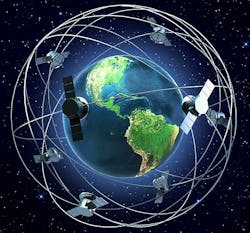L-3 to design rapidly steerable electro-optics infrared telescope for small reconnaissance satellites
WRIGHT-PATTERSON AFB, Ohio – Space electro-optics experts at L-3 Space & Sensors SSG in Wilmington, Mass., are developing a small, lightweight, and affordable infrared telescope for use on future generations of small military reconnaissance satellites operating in low-Earth orbit (LEO).
Officials of the U.S. Air Force Research Laboratory at Wright-Patterson Air Force Base, Ohio, announced a $9.2 million two-year contract to L-3 Space & Sensors on Thursday for the Agile Small-Satellite Experimental Telescope (ASSET) project.
ASSET seeks to develop an infrared telescope with size, weight, and recurring costs low enough to make it suitable for small satellites -- and with the ability to steer its instantaneous field-of-view over a large angular field-of-regard rapidly.
The Air Force Research Lab awarded the ASSET electro-optics contract to L-3 Space & Sensors on behalf of the U.S. Defense Advanced Research Projects Agency (DARPA) in Arlington, Va.
Related: NASA taps Teledyne for space-qualified electro-optical sensor for WFIRST space telescope
Small satellites operating in low-Earth-orbit can image with higher resolution and with smaller-aperture optics than those in higher orbits, DARPA researchers explain. Smaller optics and a smaller satellite bus lead to relatively low-cost satellites that can be designed and delivered quickly.
Providing persistent on-demand remote sensing from low-Earth orbit can require hundreds of satellites, which makes it imperative to keep their costs low. The sensor payloads of these satellites must cost no more than a few million dollars, and their sizes and weights must be small enough to keep the costs of satellite buses low.
At the same time, however, DARPA researchers are asking L-3 Space & Sensors to build a small-satellite infrared telescope with high performance in spatial resolution, and in its ability to re-image areas widely distributed over the field-of-regard quickly.
This rules out body-steering a fixed telescope using a satellite’s reaction wheels or control-moment gyros. Instead, L-3 Space & Sensors engineers will focus on designing an optical system able to repoint its line-of-sight telescope quickly.
Related: How does NASA's James Webb space telescope keep cool?
If L-3 Space & Sensors designers can build low-cost, high-performance agile telescopes, they will transform the types of missions that are feasible on small satellites, DARPA researchers say.
Towards this goal, L-3 Space & Sensors will build a prototype rapidly steerable agile telescope for small satellites with a telescope aperture of 30 centimeters, field of view of more than three degrees, design pass-band of three to five microns, and with band-pass filter.
The space telescope will operate in the mid-wave infrared (MWIR) band with passively cooled optics to minimize self emission. DARPA researchers are interested in using full-aperture scan mirrors to simplify thermal control and impart less reaction force during rapid motions.
L-3 Space & Sensors engineers will build a prototype optical system that, at least for now, is not for a specific satellite mission, so no spacecraft interface is necessary. Instead, they will define reasonable interfaces, estimated flight loads, and other environmental specifications to drive their design so that the prototype is suitable for a small-satellite application.
There is a possibility, however, a space flight opportunity may become available during development, so the prototype should be useable for flight after qualification.
The L-3 agile telescope will include telescope optics, agile pointing systems, a focal plane, and basic electronics to drive electromechanical or electro-optical systems for field-of-view re-pointing.
Its focal plane will include an integrated dewar cooler assembly, and will be large enough to provide diffraction-limited performance over its full field of view.
For more information contact L-3 Space & Sensors online at www.l3t.com, the Air Force Research Laboratory at www.wpafb.af.mil/afrl, or DARPA at www.darpa.mil.
Ready to make a purchase? Search the Military & Aerospace Electronics Buyer's Guide for companies, new products, press releases, and videos


